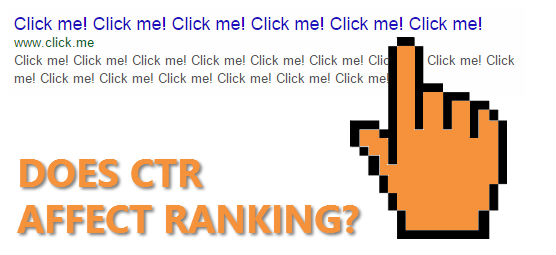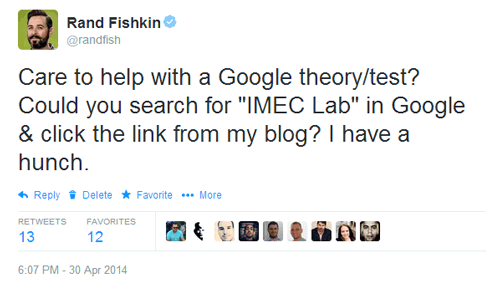
It’s a common speculation within the SEO community that CTR (Click-Through Rate – or the rate at which users “click through” to your website in the search results for a particular search query) affects the way in which Google ranks your website in their SERPs. Though this has never been confirmed by Google, nor do I expect that they would if it did, SEO industry experts have been trying to prove for years that CTR is used as one of Google’s search ranking factors.
In fact, Bing has already admitted to CTR being a factor in their search ranking algorithm back in 2010 during a conference. Though how aggressively implemented it is as a signal is something easily debated.
Why would Google use CTR as a Ranking Signal?
It makes sense for Google to reward those results in their SERPs that generate a high Click-Through Rate. After all, each Click-Through signifies a “user vote” – users are essentially casting their vote toward that result as being the most relevant to their search query based on title and meta description. Why would Google not be led to believe that a particular result is the most relevant for a search term if numerous users are considering that result to best match their search intent?
If a result positioned at the top of the first page for a query does not generate the high Click-Through Rate that Google would expect in comparison to lower ranked results, then it’s fair enough to say that that result is a waste of space. Google could easily fill that prestigious slot at the top of page one to something that will be more beneficial to Google’s users.
Unlike metrics like Bounce Rate that depend on site-side analytic tools that work with a tracking code that has to be implemented on the website itself (such as Google Analytics), Click-Through Rate is something on the “Google-side” that Google do have access to and could use as a way of ranking results. Upon registration to Webmaster Tools, we are almost immediately able to view Click-Through Rate for different keywords and web pages as well as the number of impressions that they receive. We do not need to install any tracking code for Google to have these figures; Google already has them – as does Bing for their respective search engine! Google Analytics is a tool that merely provides webmasters with insight as to how to improve the effectiveness of their marketing strategies and website functionality. Google can’t use website’s on-page analytic data to rank pages.
In addition to Click-Through Rate, Google could even use a web page’s Dwell Time. Google may not always be able to see the web page’s bounce rate, but they are able to detect whether the user returns immediately to the search results from the result which they clicked. They may use this to determine whether the page provided any value to the user. Obviously the reason for a user to return to the original search results may vary depending on the purpose of the web page, which may be to quickly deliver information to the user and that is it. In which case, Google is likely to have a way of examining the content for more context as to what the intent of the web page is and judge it accordingly.
Manipulating Google’s CTR
Even if Google were to be using CTR as a ranking signal, CTR is so easily manipulated that it could never be used as a heavy signal. At least not without being balanced against various other metrics to detect suspicious patterns in Click-Through activity.
Many people, myself included, have experimented with various blogs and websites, asking dozens if not hundreds of people around the world to search for a specific query and click on a specific result, and results have shown a correlation between manipulated CTR and ranking. Rand Fishkin from Moz asked his Twitter followers a few months ago to search for a query, Tweet back the position of the Moz result and click through to it.

But this is of course not a permanent solution and I would not advocate attempting this on anything but an experimental environment. It is suspected that Google’s preference for fresh content has a lot to do with the temporary ranking of results that are receiving a surge in clicks due to a trending popularity in the subject. But generally, Click-Through Rates tend to be consistent relative to the position and the search query. If this was a real long-term solution that worked, people would be paying internet workers in third world countries to search and click things on Google all day long. But people don’t, because Google’s not stupid.
Google have algorithmic ways of determining whether there is hint of CTR manipulation at play each time a user searches. They have a “CTR threshold” of Click-Through Rates that they have come to expect for various queries and result positions, and patents show that they may even lower the ranking of a web page or de-index it completely if the algorithm suspects that the Click-Through data has been manipulated. Too low a CTR and Google may deem the web page irrelevant to the user’s search intent; too high a CTR and the activity is likely to be unnatural.
In Google’s patent (“Methods and systems for establishing a keyword utilising path navigation information“) it seems that they also compare the geographical location of the user, based on their IP address, with that of the search result or the geographical location which is associated with the search result. (Of course they do! How else do we get our localised results?) But, in regards to this being used to detect unnatural CTR, it could only be used in conjunction with other signals to ensure that any abnormally high influx of similarly related organic visitors (geographically, demographically or otherwise) is measured against current search trends.
How CTR Affects Ad Rankings
In Adwords, Google completely and transparently rely on Click-Through Rate to calculate the Quality Score of an ad. In fact, they have stated before that they regard it as “the most significant component of Quality Score because it directly indicates which ads are most relevant to our searchers”. And a good Quality Score is vital to Google Search Network’s Ad Rank, as Ad Rank is determined by “CPC x Quality Score” (Cost Per Click multiplied by Quality Score), and then ads are sorted in descending order.

Google Adwords include past CTR for certain keywords, a display URL’s past CTR and account history (overall CTR historically) as factors that determine Quality Score. (Of course there’s much more to the Quality Score than that, but CTR is a huge component.) Like Google’s CTR threshold in search, Google expect a certain Click-Through Rate from each ad based on historical click and impressions. Ads that receive a high Click-Through Rate, and are generally of a higher quality, will be rewarded with a higher position in the paid results of Google search and can even have a lower CPC (Cost Per Click) than results ranked beneath.
This should be a huge indicator that Click-Through Rate is something that we should be monitoring for our organic search results too. Though it is unconfirmed that it is a search ranking factor, how well a web page is performing for its keywords in search is certainly something that we should be paying close attention to.
Using CTR as an Analytic Metric for On-Site SEO
Google have been trying desperately for years to stray SEO practitioners from the old beaten path of PageRank obsession. Even way back in 2011, it was published on the Google Webmaster Central blog that webmasters should be graduating to actionable metrics beyond PageRank – specifically: Conversion Rate, Bounce Rate and Click-Through Rate. Google place Click-Through Rate in very high regards, but this does not necessarily mean that CTR directly affects the way in which Google’s search algorithm chooses to rank web pages. But it certainly is an analytic metric that Google encourages webmasters to closely monitor. One that can only benefit your website by improving.
When not manipulated, Click-Through Rate is the most effective way of quantifying user interest of different results in the search results page for different queries. For both you as a webmaster and Google as a search engine.


I fully agree.\n\nIt seems they are also very interested in how many times people search for a domain name plus search term, too; such as ‘example.com red widget’. That may be seen as a vote for example.com and might, just might increase it’s relevance for that search term. Again, as you’ve pointed out, I’ve no doubt that excessive use of this would soon be spotted.
Without a doubt, Peter. I mean, you can see in practice yourself when you search for some things and Google starts suggesting brand names appended to your search query. Historically, people have obviously typed for that brand name with that keyword together, so Google is deeming those two entities relevant to each other and suggesting it to its searchers.